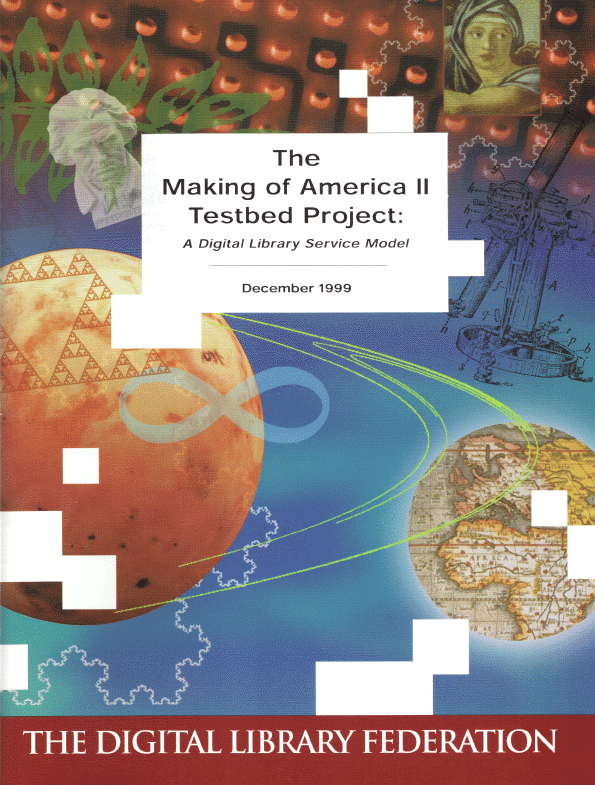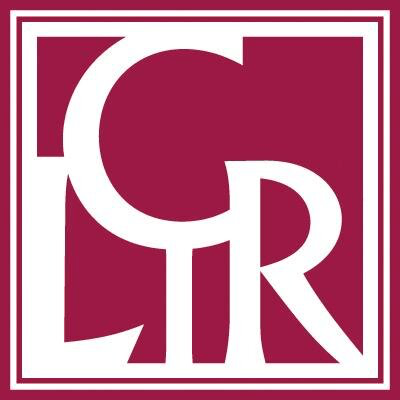The Making of America II Testbed Project:
A Digital Library Service Model

by Bernard J. Hurley
John Price-Wilkin
Merrilee Proffitt
Howard Besser
December 1999
Copyright 1999 by the Council on Library and Information Resources. No part of this publication may be reproduced or transcribed in any form without permission of the publisher. Requests for reproduction should be submitted to the Director of Communications at the Council on Library and Information Resources.
- Planning Phase
- Research and Production Phase
- Dissemination Phase
PART II: The MoA II Digital Library Service Model
- Overview
- Services Layer
- Tools Layer
- Digital Library Objects Layer
- A Model for Digital Library Objects
- Adding Classes and Content to the MoA II Object Model
- Adding Metadata to the MoA II Object Model
- Adding Methods to the MoA II Object Model
- Object-Oriented Design as Part of the Object Model
- Defining the Difference between Behaviors and Methods
- Methods as Part of the MoA II Digital Object Model
- Building MoA II Archival Objects
- Summary
PART III: Implementing the MoA II Service Model
- Selecting Digital Archival Classes
- MoA II Testbed Services and Tools
- Behaviors and Methods-“What Tools Do”
- Definitions
- Contexts and Constraints
- Navigation
- General Navigation
- Image Navigation
- Display and Print
- Combination or Comparison
- Repository Search
- Color Analysis
- Bookmarks, Annotations, and Links
- MoA II Metadata
- Descriptive Metadata
- Structural Metadata
- Structural Metadata Elements and Features Tables
- Administrative Metadata
- Administrative Metadata Elements and Features Tables
- Encoding: Best Practices
- Encoding Archival Object Content and Finding Aids
- Encoding to Encapsulate Metadata and Content inside the Archival Object
Appendix: Structural Metadata Notes
TABLES
- Table 1. Structural metadata elements, object level
- Table 2. Structural metadata elements, sub-object level
- Table 3. Administrative metadata elements for the creation of a digital master image
- Table 4. Administrative metadata elements for identifying and viewing the digital image files
- Table 5. Administrative metadata elements for linking the parts of a digital object or its instantiations, providing context
- Table 6. Administrative metadata elements for linking the parts of a digital object or its instantiations, providing context, and ownership, rights, and reproduction information
The Digital Library Federation
On May 1, 1995, 16 institutions created the Digital Library Federation (additional partners have since joined the original 16). The DLF partners have committed themselves to “bring together-from across the nation and beyond-digitized materials that will be made accessible to students, scholars, and citizens everywhere.” If they are to succeed in reaching their goals, all DLF participants realize that they must act quickly to build the infrastructure and the institutional capacity to sustain digital libraries. In support of DLF participants’ efforts to these ends, DLF launched this publication series in 1999 to highlight and disseminate critical work.
About the Authors
Bernard J. Hurley is the Berkeley Library’s director of library technologies. He formerly served as the director for library systems, beginning in 1981, and has worked in the field of library automation for the last seventeen years. While at Berkeley, he has played a central role in developing the GLADIS System, Berkeley’s online catalog, catalog maintenance, authority control, and circulation system, and its access to the Berkeley Campus Information Network.
John Price-Wilkin is head of Digital Library Production Services (DLPS) at the University of Michigan, a position he has held since its inception in 1996. A federated organization, DLPS is responsible for mounting and maintaining licensed content for the University of Michigan and several other universities, and for text conversion projects such as the Making of America. Among the units in the DLPS is the University of Michigan’s Humanities Text Initiative, an organization responsible for SGML document creation and online systems, which Price-Wilkin founded in 1994.
Merrilee Proffitt is director of digital archive development at the Bancroft Library, University of California at Berkeley. She has worked for the Berkeley Library since 1988. Ms. Proffitt has a broad range of experience in digital library projects, especially those relating to special collections. She has expertise in database development, text encoding, and metadata, and has managed a range of digital imaging and text encoding projects.
Howard Besser is an associate professor at UCLA’s School of Education and Information, where he teaches and does research on multimedia, image databases, digital libraries, Web design, information literacy, distance learning, intellectual property, and the social and cultural impact of new information technologies. Besser has been involved with the Dublin Core metadata standard since its inception, and has recently been promoting the extension of metadata activities beyond the “discovery” orientation of the Dublin Core. He was an organizer of a DLF/NISO meeting to develop metadata standards for digital images, and was member of the metadata committee of the US/European Community Digital Collaboratory, laying out directions for future digital library research.
Acknowledgments
No work is produced in a vacuum. The authors would like to thank the following individuals who offered guidance and wisdom to this project: Caroline Arms, Rick Beaubien, Robert DeCandido, Dale Flecker, Rebecca Graham, Susan Hamburger, Bonnie Hardwick, John Hassan, Peter Hirtle, Tim Hoyer, Dan Johnston, Sue Kellerman, Heike Kordish, Steven Mandeville-Gamble, Jerome McDonough, Ralph Moon, Sue Rosenblatt, Kathlin Smith, Christie Stephenson, and Ann Swartzell.
Many thanks are also due to the institutions that participated in the MoA II project. Without the expert staff working on the project, none of this would have been possible.
Finally, we owe a debt of gratitude to the organizations that funded the MoA II project itself. Thanks are due to the Digital Library Federation, for funding the research phase of the MoA II project, and to the National Endowment for the Humanities for funding the testbed phase of the project.
Foreword
Metadata is what makes it possible to locate, provide access to, navigate, and manage digital information in diverse forms. Ongoing work on metadata definition has been critical to the development of digital libraries. The extension and refinement of the Dublin Core, efforts to establish a set of technical metadata elements for images, and other initiatives are expanding the application and usefulness of metadata. Echoing earlier published works, this paper emphasizes the importance of metadata in those developments.
The work of the Making of America II Testbed Project reported in this paper represents a singular effort in digital library development to find ways to provide access to and navigate a variety of materials. In this endeavor, a digital library service model has been defined that encapsulates the interaction of digital objects (including their metadata), tools, and services based on principles of object-oriented design. In developing the digital library service model, project participants did extensive work to identify and define the structural and administrative (often referred to as technical) metadata elements that are crucial in the development of the digital library services and tools.
The Digital Library Federation’s support of this work was driven by two of its program priorities: to stimulate the development of a core digital library infrastructure and to organize, provide access to, and preserve knowledge. This publicationDLF’s thirdfurthers the interests of the Federation and its members by presenting one possible model of digital library development for review and discussion within the DLF community and the digital library community at large.
Rebecca Graham
Reader’s Guide
Drawing on the example of the Making of America II Testbed Project, this report examines an object-oriented approach to digital library construction, the collection of structural and administrative metadata, and the development of tools to assist scholars. It is divided into four main parts. Readers should approach the report part by part, focusing on those areas of particular interest.
- The Executive Summary provides an overview of the MoA II Testbed Project and describes the content and objectives of this report.
- Part I, Project Background, describes the history of the project and outlines the activities to be undertaken during each of the three phases.
- Part II, The MoA II Digital Library Service Model, reviews the technical details of the model for digital library objects. It briefly describes the three layers of the project: services, tools, and digital library objects.
- Part III, Implementing the Service Model, is the most detailed section of the report. It discusses the use of tools in the digital library, presents an overview of structural and administrative metadata, and provides recommendations for the collection of metadata.
Recommendations for imaging are not covered in this report. This topic will be covered extensively in Guides to Quality in Visual Resource Imaging, which the Council on Library and Information Resources and The Research Libraries Group will publish on the Web in early 2000.

